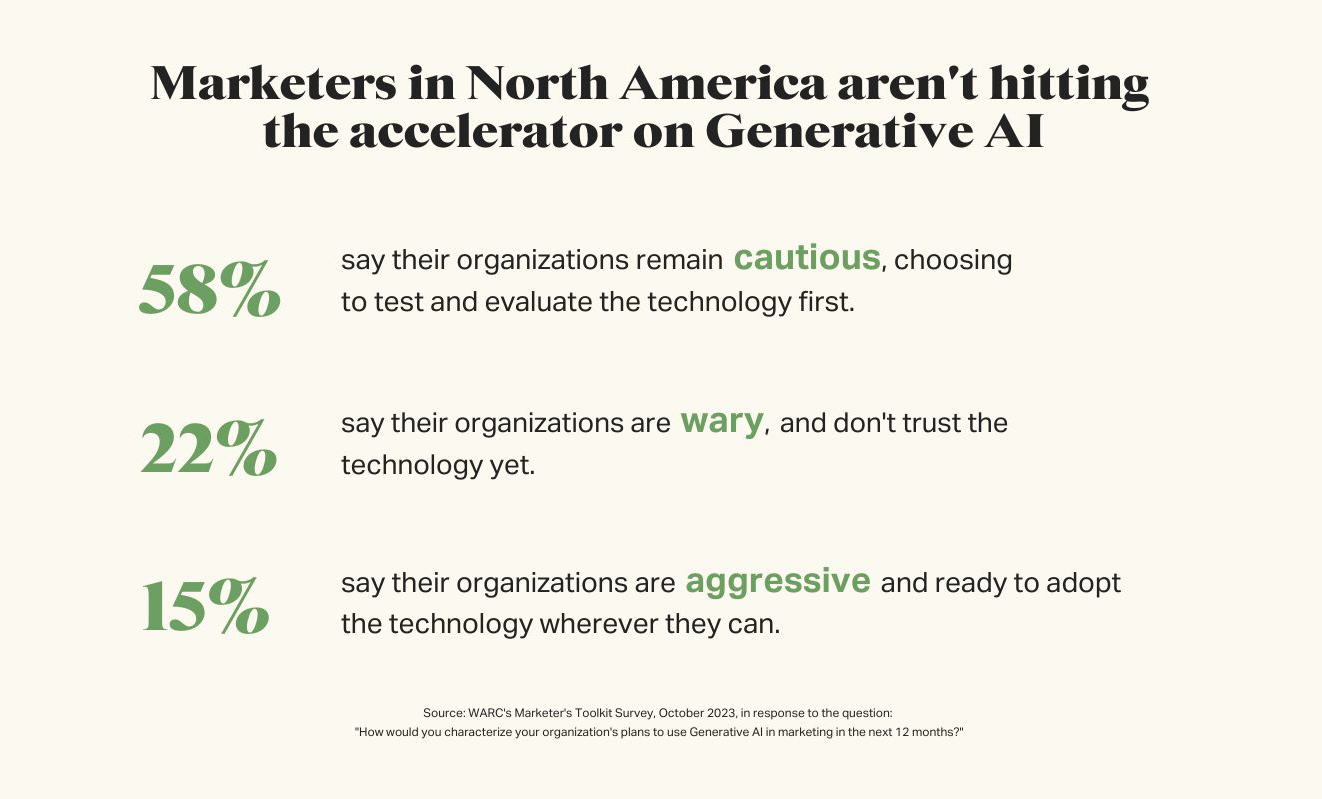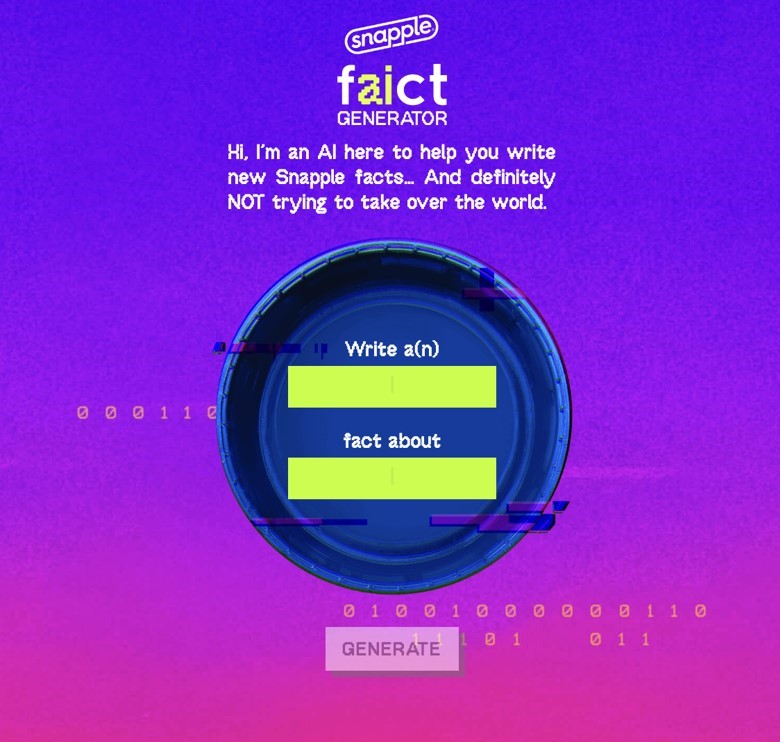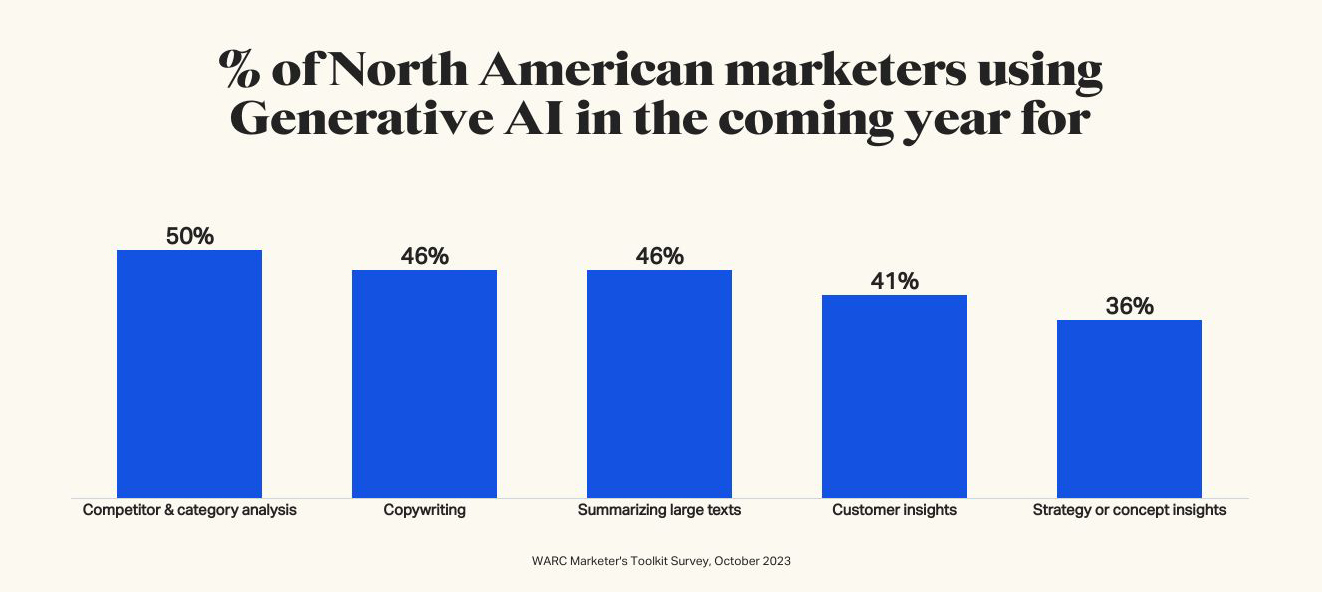In whatever context it’s being discussed, Generative AI is the topic that seemingly everyone in US marketing is talking about this year. In this article introducing the latest Spotlight US, Americas Editor Ann Marie Kerwin examines what’s beyond the buzz and what marketers and agencies are learning after early experiments with these tools.
This article is part of the October 2023 Spotlight US series, ‘Working with Generative AI in America’. Read more
2023 is the year in which nearly every professional conversation somehow turns to Generative AI, even if it’s just the oft-repeated prediction of “when Gen AI replaces us all.”
Forrester Research predicts that by 2030, 32,000 US advertising jobs will be affected by Generative AI’s automation, or 7.5% of the total agency workforce. So that conversational tic this year reflects a real change afoot for marketing teams.
This is why we focused WARC’s latest Spotlight US on this ubiquitous subject, to provide a temperature check on what marketers and agencies are starting to do, and what questions need to be answered as teams start to experiment with – and learn the power and peril of – Gen AI.
It’s time for cautious exploration
Most marketer industry pros in North America (58%) plan to approach the use of Gen AI over the next year cautiously, according to a WARC Toolkit survey conducted earlier this month (Marketer’s Toolkit 2024 coming soon in November). They’re choosing to test and evaluate the technology first. A smaller group (15%) are aggressively pursuing its use, and are ready to adopt the technology wherever they can, while 22% are wary, and don’t yet trust it.

A cautious or wary approach does make sense, given 43% of respondents to a June Salesforce survey of 1,000 marketers said they don’t know how to get the most value out of the technology – and 67% of respondents said their company data is not yet properly set up for its use. (For additional data about marketer uses of – and attitudes toward – Gen AI, check out this Spotlight’s infographic.)
Proper data maintenance is going to have to go on the list of things to do before any brand starts using Gen AI to create marketing. As IBM Consulting’s Alexis Zamkow notes, companies are going to have to track the source and lineage of the data they use for both legal and branding considerations, because they may have to share that eventually with consumers: “As consumer awareness of Generative AI content grows, there are calls for greater identification of content that has been primarily generated through AI.” She predicts businesses could be required to offer easy access to the source data that was used to generate content, which would demand a high degree of data management.
So how else to get started? WARC tapped into the work of the US consultant Joanne Davis, who surveyed both agencies and marketers this year through the industry trade bodies the 4As and ANA, to illuminate how each approaches the use of these tools. Brands don’t want to be the next example of what went wrong with Gen AI, so “it’s imperative that each understand the potential advantages and pitfalls, and map out a strategic plan for how to use these tools,” Davis wrote. Using the results of her surveys, she developed a series of key questions addressing topics such as strategy, training, budget and legal implications that need to be answered before brands use the output from these tools.
How to strategically, and ethically, use Gen AI
Deutsch LA’s Ivan Perez-Armendariz, in his article, takes note of the industry’s pervasive replacement anxiety: “Agency staff are asking, will Generative AI take my job? In the immediate future, the answer is likely no. But a more realistic threat may be to consider if you, with AI assistance, will replace you, without AI assistance.” He believes marketing teams need to adopt what he calls the “AI-assisted Mindset,” and teams can start to employ that for immediate experimentation in everyday, non-commercial agency tasks in research and insights.
“Our approach to AI integration is both cautious and forward-thinking,” Perez-Armendariz writes. “For production-ready art and content, we strictly limit our usage of Generative AI tools to those that offer full indemnification, ensuring both quality and security. However, when it comes to concepting and ideation, we advocate for unrestricted exploration of all available tools, fostering innovation and expansive thinking.”
Earlier this year, his agency discovered a clever use of Gen AI inspired by those classic facts under the bottle caps of the juice and tea brand Snapple. The agency introduced “Snapple fAIcts,” a platform where users could generate their own quirky facts using Gen AI. The hook? These AI-crafted facts have the chance to grace Snapple bottle caps in 2024. It’s a testament to how quickly the agency and marketer are adapting and integrating AI into projects.

Other tasks that North American marketers expect to use Gen AI for range from competitor and category analysis to insights, according to WARC’s Toolkit survey.

It’s clear that each organization will need to evaluate where it believes Gen AI tools will help it achieve its business objectives. As Imteaz Ahamed, Reckitt’s Director, Performance Marketing – Nutrition, noted in his interview with WARC, “I always like to start with, what’s the ultimate problem that we’re trying to solve? And then realizing that all technology, be it Generative AI or otherwise, is an enabler to solving a problem – it’s not the solution.”
Gen AI delivers usable work, but often not meaningful work
Because large language models work by making informed guesses as to what the next logical word should be, at the moment, much of what they produce is, well, mediocre. This year’s WARC’s Future of Strategy survey found that only 29% of strategists have the time to conduct boots-on-the-ground research more than monthly. And 11% said they are unable to do any qualitative research. Which means, unfortunately, due to a lack of time and resources, strategic and creative teams can produce work that is also mediocre.
Accenture Song’s Stephen Lampert quotes in his article, “Most business leaders don’t care that the marketing work AI produces is mediocre. Because these leaders think most of the marketing work we produce is mediocre (and at least AI’s mediocre work is instant, free, and comes in endless volumes).”
On a recent WARC podcast discussing the future of strategy, Elizabeth Paul, Chief Strategy Officer of The Martin Agency, threw out the rather depressing stat that 84% of ads aren’t seen, that they are either actively avoided or passively ignored, essentially wallpaper. No strategy or creative team wants to be producing work that goes unseen, and great work using Gen AI tools is only going to happen if it is able to reflect real human experiences that cause actual humans to respond.
Gen AI will reshape how we work, but humans will decide how
Gen AI may be the future, but Gen Z, which values imperfection, authenticity and transparency, doesn’t see itself as the Gen AI generation. Susan Vugts, Managing Director, and Irene Schrader, Junior Strategist, of the agency SuperHeroes, note that younger consumers can be deeply skeptical of Gen AI replacing artistic innovation, and want recognition for the human creators behind Gen AI output.
In her recent opinion piece, Raquelle Zuzarte argues that human ingenuity is what will create a propulsive effect for Gen AI tools. “If AI is the rocketship, then we, the humans, represent the rocket scientists, astronauts, and mission control team. It’s essential to understand that AI, like a spacecraft, is a tool, a conduit through which human ingenuity flows.”
Reckitt’s Ahamed believes that organizations have to be capable of learning to keep up with a rapidly changing landscape. “For me, it’s the ability to unlearn and re-learn. …This Generative AI space, and how we do marketing, probably won’t look the same in three years’ time. The way we have created products and done market research is probably not going to look the same. So the companies that can understand what they can let go of and be okay with that will win.”
WARC has more AI coverage coming in this year’s Marketer’s Toolkit report, out next month. It will include the result of a global survey on AI attitudes, usage and plans, and there will be a WARC podcast coming at the end of November. And we will continue to be adding to our reservoir of evidence and guidance on what’s working in AI throughout next year.
Read more in this Spotlight series
Spotlight US: How US marketers are starting to use Gen AI
Ann Marie Kerwin
WARC
Q&A: A marketer’s view of how to work with Generative AI tools
Imteaz Ahamed
Reckitt
US Gen Zers and AI: What brands need to consider
Susan Vugts and Irene Schrader
SuperHeroes
Generative AI in marketing: How agencies can embrace an ethical future
Ivan Perez-Armendariz
Deutsch LA
Generative AI foundations require care with marketing data – and that requires human attention
Alexis Zamkow
IBM Consulting
Mediocre work from Generative AI may replace your job, but only humans can deliver deeper insights
Stephen Lampert
Accenture Song
Ready for Launch: How Gen AI is already transforming marketing
Jeff Katzin, Laura Beaudin and Max Waldron
Bain & Company
Setting rules of engagement for marketers and agencies using Generative AI
Joanne Davis
Joanne Davis Consulting

